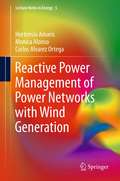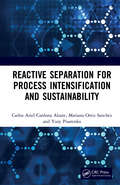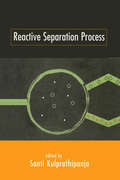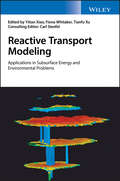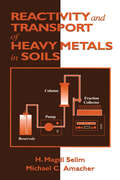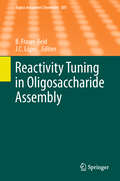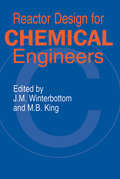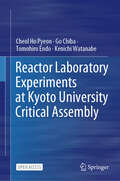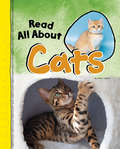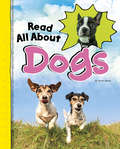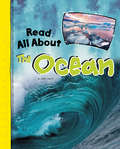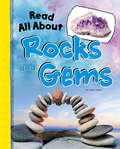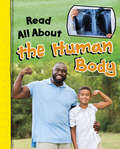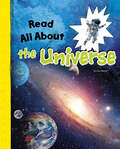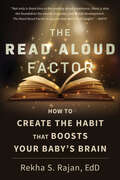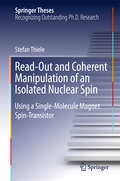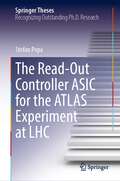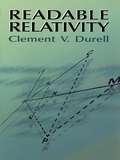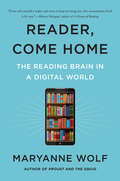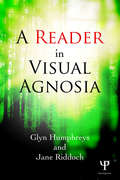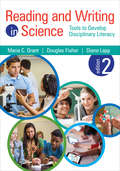- Table View
- List View
Reactive Power Management of Power Networks with Wind Generation
by Monica Alonso Hortensia Amaris Carlos Alvarez OrtegaAs the energy sector shifts and changes to focus on renewable technologies, the optimization of wind power becomes a key practical issue. Reactive Power Management of Power Networks with Wind Generation brings into focus the development and application of advanced optimization techniques to the study, characterization, and assessment of voltage stability in power systems. Recent advances on reactive power management are reviewed with particular emphasis on the analysis and control of wind energy conversion systems and FACTS devices. Following an introduction, distinct chapters cover the 5 key areas of FACTS devices, voltage stability, wind generators, reactive power optimization and management. These are supported with applications and example including real-life data from the Spanish Power system. Together with power system engineers, operators and planners will also benefit from this insightful resource. Reactive Power Management of Power Networks with Wind Generation provides a key reference to advanced undergraduate and graduate students in electrical and power engineering.
Reactive Separation for Process Intensification and Sustainability
by Carlos Ariel Alzate Mariana Ortiz Sanchez Pisarenko Yury AndrianovichThis book describes, analyses and discusses the main principles, phenomena and design strategies of reactive separation processes with an emphasis on the intensification as a basis of the sustainability. Different reactive separation processes are explained in detail to show the phenomena and with the purpose of understanding when their use allows advantages based on the output results. Case examples are analysed and the perspective of these processes in the future is discussed. The overall sustainability of reactive separation processes in the industry is also explained separately.
Reactive Separation Processes
by KulprathipanjaThis book summarizes the available information in six known areas of reactive separation: reaction/distillation, reaction/extraction, reaction/absorption, reaction/adsorption, reaction/membrane, and reaction/crystallization.
Reactive Transport Modeling: Applications in Subsurface Energy and Environmental Problems
by Yitian Xiao Fiona Whitaker Tianfu Xu Carl SteefelTeaches the application of Reactive Transport Modeling (RTM) for subsurface systems in order to expedite the understanding of the behavior of complex geological systems This book lays out the basic principles and approaches of Reactive Transport Modeling (RTM) for surface and subsurface environments, presenting specific workflows and applications. The techniques discussed are being increasingly commonly used in a wide range of research fields, and the information provided covers fundamental theory, practical issues in running reactive transport models, and how to apply techniques in specific areas. The need for RTM in engineered facilities, such as nuclear waste repositories or CO2 storage sites, is ever increasing, because the prediction of the future evolution of these systems has become a legal obligation. With increasing recognition of the power of these approaches, and their widening adoption, comes responsibility to ensure appropriate application of available tools. This book aims to provide the requisite understanding of key aspects of RTM, and in doing so help identify and thus avoid potential pitfalls. Reactive Transport Modeling covers: the application of RTM for CO2 sequestration and geothermal energy development; reservoir quality prediction; modeling diagenesis; modeling geochemical processes in oil & gas production; modeling gas hydrate production; reactive transport in fractured and porous media; reactive transport studies for nuclear waste disposal; reactive flow modeling in hydrothermal systems; and modeling biogeochemical processes. Key features include: A comprehensive reference for scientists and practitioners entering the area of reactive transport modeling (RTM) Presented by internationally known experts in the field Covers fundamental theory, practical issues in running reactive transport models, and hands-on examples for applying techniques in specific areas Teaches readers to appreciate the power of RTM and to stimulate usage and application Reactive Transport Modeling is written for graduate students and researchers in academia, government laboratories, and industry who are interested in applying reactive transport modeling to the topic of their research. The book will also appeal to geochemists, hydrogeologists, geophysicists, earth scientists, environmental engineers, and environmental chemists.
Reactivity and Transport of Heavy Metals in Soils
by H. Magdi Selim Michael C. AmacherThe fate of heavy metal particles in the environment is important because they tend to be reactive, mobile, and highly toxic. Reactivity and Transport of Heavy Metals in Soils examines the sometimes complex interactions that occur between metals and the soil they occupy. It discusses basic kinetic concepts and covers the predictability and consequences of metal-soil interactions.This practical guide presents and explains heavy metal issues crucial to hazardous waste site cleanup, including:
Reactivity Tuning in Oligosaccharide Assembly
by Bert Fraser-Reid J. Cristóbal LópezArmed-Disarmed Effects in Carbohydrate Chemistry: History, Synthetic and Mechanistic Studies, by Bert Fraser-Reid and J. Cristóbal López * A Survey of Ley's Reactivity Tuning in Oligosaccharide Synthesis, by Ana M. Gómez * "Active-Latent" Thioglycosyl Donors and Acceptors in Oligosaccharide Syntheses, by Tze Chieh Shiao and René Roy * Effect of Electron-Withdrawing Protecting Groups at Remote Positions of Donors on Glycosylation Stereochemistry, by Kwan Soo Kim and Dae-Hwan Suk * Influence of Protecting Groups on the Reactivity and Selectivity of Glycosylation: Chemistry of the 4,6-O-Benzylidene Protected Mannopyranosyl Donors and Related Species, by Sylvain Aubry, Kaname Sasaki, Indrajeet Sharma and David Crich * Superarmed and Superdisarmed Building Blocks in Expeditious Oligosaccharide Synthesis, by Hemali D. Premathilake and Alexei V. Demchenko * Programmable One-Pot Glycosylation, by Chung -Yi Wu and Chi -Huey Wong * Uronic Acids in Oligosaccharide and Glycoconjugate Synthesis, by Jeroen D. C. Codée, Alphert E. Christina, Marthe T. C. Walvoort, Herman S. Overkleeft and Gijsbert A. van der Marel
Reactor Design for Chemical Engineers
by J.M. WINTERBOTTOM AND M.B. KINGIntended primarily for undergraduate chemical-engineering students, this book also includes material which bridges the gap between undergraduate and graduate requirements. The introduction contains a listing of the principal types of reactors employed in the chemical industry, with diagrams and examples of their use. There is then a brief exploration of the concepts employed in later sections for modelling and sizing reactors, followed by basic information on stoichiometry and thermodynamics, and the kinetics of homogeneous and catalyzed reactions. Subsequent chapters are devoted to reactor sizing and modelling in some simple situations, and more detailed coverage of the design and operation of the principal reactor types.
Reactor Laboratory Experiments at Kyoto University Critical Assembly
by Cheol Ho Pyeon Go Chiba Tomohiro Endo Kenichi WatanabeThis open access is an educational text on reactor physics experiments and is described based on a careful examination of the contents and pedagogical benefits obtained from the book Nuclear Reactor Physics Experiments by T. Misawa, H. Unesaki, and C. H. Pyeon (2010) from Kyoto University Press, Japan. The current volume comprehensively covers basic and applied topics on experiment using nuclear reactors, including exponential experiment, uranium enrichment measurement and subcriticality measurements, in addition to approach-to-criticality experiment, control rod calibration experiment, and reaction rate measurement by the activation foil method. This book is intended for graduate students who have already studied reactor physics and radiation detection in an undergraduate program. Readers who have not yet studied these two areas or who wish to review them are recommended to read the companion book Introduction to Nuclear Reactor Experiments, by G. Wakabayashi, T. Yamada, T. Endo, and C.H. Pyeon (2023) from Springer, covering basic concepts and theories of reactor physics and radiation detection. This volume provides a systematic understanding of reactor physics experiments, complemented by its companion book by Wakabayashi et al.
Read All About Cats (Read All About It)
by Jaclyn JaycoxDid you know cats sleep around 15 hours a day? Have you heard they can make about 100 different sounds? Find out all about cats' senses, life cycles, behavior, and more in this fact-filled book. It's perfectly designed to introduce young children to the wonders of nonfiction. Stunning photos give readers an up-close look at these feline friends. A Table of Contents makes the information fun and easy-to-find.
Read All About Dogs (Read All About It)
by Jaclyn JaycoxDid you know all dogs have a different nose print? Have you wondered how many breeds of dogs there are? Young readers will learn about dog's senses, behavior, life cycle, and more in this fact-filled book. Stunning photos and a Table of Contents help introduce children to the wonderful world of nonfiction.
Read All About The Ocean (Read All About It)
by Jaclyn JaycoxHave you wondered how the oceans affect the weather? Do you know what kinds of creatures you can find below the water's surface? Explore the world's oceans in this fact-filled book. Striking photos and simple text make this a perfect introduction to nonfiction for young children. A Table of Contents splits the information into sections, making it fun and easy-to-find.
Read All About Rocks and Gems (Read All About It)
by Jaclyn JaycoxRocks are all around you. They are in your house, backyard, and even your food! Rocks are grouped into types, like sedimentary, igneous, and metamorphic. Some rocks are actually minerals, and from minerals we get beautiful gemstones. This fact-filled book is perfectly designed to introduce young children to the wonders of nonfiction. A Table of Contents makes the information fun and easy-to-find.
Read All About the Human Body (Read All About It)
by Claire ThropHow many bones are in the human body? Find out all about the body and how it works in this fact-filled book. It's perfectly designed to introduce young children to the wonders of nonfiction. Stunning art and photos give readers an up-close look at our our body parts and systems, and how they all work together to keep us going!
Read All About the Universe (Read All About It)
by Lucy BeevorJust how big is the universe? Find out all about the universe and its planets, stars, and more in this fact-filled book. It's perfectly designed to introduce young children to the power of nonfiction. Stunning art and photos give readers a fascinating look at the wonders of the universe, from the Earth, moon, sun, and beyond!
The Read Aloud Factor: How to Create the Habit That Boosts Your Baby's Brain
by Rekha S. RajanWe have always known that reading aloud is an important way to bond with your baby and develop language skills. Now neuroscience research is showing us the long-term benefit that reading aloud has for children—all the way into adulthood. Author Rekha S. Rajan was part of current research that shows individuals who were read to more frequently as children had a measurably healthier brain in old age.This innovative and accessible book incorporates the latest research on brain development, describes how reading aloud supports language and social-emotional development, and gives parents and caretakers what they need to make read alouds a regular and enjoyable part of the family routine.
Read, Learn & Create--The Nature Craft Book
by Clare BeatonPerfect for your young explorers and your elementary artists. Make a craft inspired by nature--and learn something, too!What can you create with some backyard objects and tissue paper? Your very own flower crown! Use easy-to-follow directions to make fifteen crafts (and two recipes!) with each one focused on nature. Crafts include fun facts and additional resources, giving covert learning opportunities for your little explorer and reducing screentime.
Read-Out and Coherent Manipulation of an Isolated Nuclear Spin
by Stefan ThieleThis thesis sheds new light on the worldwide first electrical manipulation of a single nuclear spin. Over the last four decades, the size of a bit, the smallest logical unit in a computer, has decreased by more than two orders of magnitude and will soon reach a limit where quantum phenomena become important. Inspired by the power of quantum mechanics, researchers have already identified pure quantum systems, having, analog to a classical bit, two controllable and readable states. In this regard, the inherent spin of electrons or nuclei with its two eigenstates, spin up and spin down, is a promising candidate. Using expertise in the field of single-molecule magnets, the author developed a molecular transistor, which allows quantum information to be written onto a single nuclear spin by means of an electric field only, and, in addition, enables the electronic read-out of this quantum state. This novel approach opens a path to addressing and manipulating individual nuclear spins within a very confined space (a single molecule), at high speed. Thus, the author was able to show that single molecule magnets are promising candidates for quantum information processing, which is triggering a new field of research towards molecular quantum electronics.
The Read-Out Controller ASIC for the ATLAS Experiment at LHC (Springer Theses)
by Stefan PopaThis thesis presents the complete chain from specifications to real-life deployment of the Read Out Controller (ROC) ASIC for the ATLAS Experiment at LHC, including the design of the FPGA-based setup used for prototype validation and mass testing of the approximately 6000 chips. Long-lasting experiments like the ATLAS at the LHC undergo regular upgrades to improve their performance over time. One of such upgrades of the ATLAS was the replacement of a fraction of muon detectors in the forward rapidities to provide much-improved reconstruction precision and discrimination from background protons. This new instrumentation (New Small Wheel) is equipped with custom-designed, radiation-hard, on-detector electronics with the Read Out Controller chip being a mission-critical element. The chip acts as a clock and control signals distributor and a concentrator, buffer, filter and real-time processor of detector data packets. The described and deployed FPGA-based test setup emulates the asynchronous chip context and employs optimizations and automatic clock and data synchronization. The chip's tolerance to nuclear radiation was evaluated by recording its operation while controlled ultrafast neutron beams were incident to its silicon die. Predictions for the operating environment are made. A proposed implementation of an FPGA Integrated Logic Analyzer that mitigates the observed limitations and constraints of the existing ones is included.
Readable Relativity
by Clement V. DurellConcise and practical, this text by a renowned teacher sketches the mathematical background essential to understanding the fundamentals of relativity theory. Subjects include the velocity of light, measurement of time and distance, and properties of mass and momentum, with numerous diagrams, formulas, and examples, plus exercises and solutions. 1960 edition.
Reader, Come Home: The Fate of the Reading Brain in a Digital World
by Maryanne WolfFrom the author of Proust and the Squid, a lively, ambitious, and deeply informative epistolary book that considers the future of the reading brain and our capacity for critical thinking, empathy, and reflection as we become increasingly dependent on digital technologies. <P><P>A decade ago, Maryanne Wolf’s Proust and the Squid revealed what we know about how the brain learns to read and how reading changes the way we think and feel. Since then, the ways we process written language have changed dramatically with many concerned about both their own changes and that of children. New research on the reading brain chronicles these changes in the brains of children and adults as they learn to read while immersed in a digitally dominated medium. <P><P>Drawing deeply on this research, this book comprises a series of letters Wolf writes to us—her beloved readers—to describe her concerns and her hopes about what is happening to the reading brain as it unavoidably changes to adapt to digital mediums. Wolf raises difficult questions, including: <P><P>Will children learn to incorporate the full range of "deep reading" processes that are at the core of the expert reading brain? <P><P>Will the mix of a seemingly infinite set of distractions for children’s attention and their quick access to immediate, voluminous information alter their ability to think for themselves? <P><P>With information at their fingertips, will the next generation learn to build their own storehouse of knowledge, which could impede the ability to make analogies and draw inferences from what they know? <P><P>Will all these influences, in turn, change the formation in children and the use in adults of "slower" cognitive processes like critical thinking, personal reflection, imagination, and empathy that comprise deep reading and that influence both how we think and how we live our lives? <P><P>Will the chain of digital influences ultimately influence the use of the critical analytical and empathic capacities necessary for a democratic society? <P><P>How can we preserve deep reading processes in future iterations of the reading brain?Who are the "good readers" of every epoch? <P><P>Concerns about attention span, critical reasoning, and over-reliance on technology are never just about children—Wolf herself has found that, though she is a reading expert, her ability to read deeply has been impacted as she has become, inevitably, increasingly dependent on screens. <P><P>Wolf draws on neuroscience, literature, education, technology, and philosophy and blends historical, literary, and scientific facts with down-to-earth examples and warm anecdotes to illuminate complex ideas that culminate in a proposal for a biliterate reading brain. Provocative and intriguing, Reader, Come Home is a roadmap that provides a cautionary but hopeful perspective on the impact of technology on our brains and our most essential intellectual capacities—and what this could mean for our future.
A Reader in Visual Agnosia: To See But Not To See
by Glyn Humphreys Jane RiddochThe case study of John has provided a unique insight into the nature of visual agnosia and more broadly into the underlying processes which support human vision. After suffering a stroke, John had problems in recognizing common objects, faces, seeing colours, reading and finding his way around his environment. A Reader in Visual Agnosia brings together the primary scientific papers describing the detailed investigations for each visual problem which the authors carried out with John, known as patient HJA. This work was summarised initially in To See But Not To See (1987), and 26 years later in A Case Study in Visual Agnosia Revisited (2013). The chapters are divided into 6 parts corresponding to the key areas of investigation: Integrative visual agnosia Perception of global form Face perception Colour perception Word recognition Changes over time Each part contains a short introduction, written by the two leading researchers who worked with John, which highlights the relations between the papers and demonstrates the pathway of the case analysis. The book will be invaluable to students and researchers in visual cognition, cognitive neuropsychology and vision neuroscience.
Readiness Issues Related to Research in the Biological and Physical Sciences on the International Space Station
by National Research CouncilThe National Academies Press (NAP)--publisher for the National Academies--publishes more than 200 books a year offering the most authoritative views, definitive information, and groundbreaking recommendations on a wide range of topics in science, engineering, and health. Our books are unique in that they are authored by the nation's leading experts in every scientific field.
Reading and Note Taking Guide Level A: Focus on California Life Science
by Pearson Prentice HallThis Reading and Note Taking Guide helps students succeed in their study of science. Working through the exercises will help them understand and organize the concepts presented in the textbook. The completed worksheets then become easy-to-follow study guides for test preparation.
Reading and Writing in Science: Tools to Develop Disciplinary Literacy
by Douglas Fisher Maria C. Grant Diane K. LappEngage your students in scientific thinking across disciplines! Did you know that scientists spend more than half of their time reading and writing? Students who are science literate can analyze, present, and defend data – both orally and in writing. The updated edition of this bestseller offers strategies to link the new science standards with literacy expectations, and specific ideas you can put to work right away. Features include: A discussion of how to use science to develop essential 21st century skills Instructional routines that help students become better writers Useful strategies for using complex scientific texts in the classroom Tools to monitor student progress through formative assessment Tips for high-stakes test preparation
Reading and Writing in Science: Tools to Develop Disciplinary Literacy
by Maria C. Grant Douglas Fisher Diane K. LappEngage your students in scientific thinking across disciplines! Did you know that scientists spend more than half of their time reading and writing? Students who are science literate can analyze, present, and defend data – both orally and in writing. The updated edition of this bestseller offers strategies to link the new science standards with literacy expectations, and specific ideas you can put to work right away. Features include: A discussion of how to use science to develop essential 21st century skills Instructional routines that help students become better writers Useful strategies for using complex scientific texts in the classroom Tools to monitor student progress through formative assessment Tips for high-stakes test preparation
